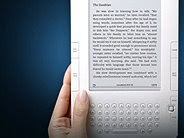
SEATTLE--Amazon wanted to make the Kindle 2 hot, but not too hot.
It gave it a slimmer design and more storage, but there are a lot of things Amazon could have added, but didn't. Things like a color display not only would make the device pricier and give it a shorter battery life, but would also make the gadget uncomfortable to hold.
Amazon CEO Jeff Bezos holds up a Kindle 2 at the device's recent launch in New York City.
(Credit: David Carnoy/CNET Networks)
"One of the great things about Kindle is it doesn't ever get hot," Amazon Vice President Ian Freed said in an interview at Amazon's downtown office here. That's important, Freed said, given that the company has one main goal with the Kindle--making the product as invisible to users as possible when they are reading.
"The most important thing for the Kindle to do is to disappear," Freed said. That was the goal with the first device and was also a key factor in deciding what would go in the sequel, which started shipping on Monday. There are the obvious factors, like the thinner, sleeker design. But there are also things like an improved cellular modem. As a result, Kindle users will find themselves out of range in fewer places to get updates or buy a new book.
One of the biggest new features is one that is impossible to see--the new Whisper Sync feature that will eventually let people read the same electronic book on multiple devices, including Kindles and cell phones.
Although he wouldn't say just when people will have Kindle content on their cell phones, Freed did confirm that one won't need to have a Kindle device to read Kindle content, though he suspects some of those who try Kindle on a cell phone will ultimately buy Amazon's device.
The cell phone option, like a controversial new text-to-speech feature built into the Kindle 2, is more designed for short bits of content than as the primary mode of reading, Freed said. A cell phone is good for those unexpected times where one has a few minutes to read, while text-to-speech is good for those who are right in the middle of a cliffhanger and have to get in the car or cook dinner.
Watch CBS Videos Online
On the text-to-speech front, Amazon has come under fire for trying to take over for the audio book market, but Freed noted that only a fraction of books even come out in audio form. He also noted that the feature works with blogs, newspapers, and other content.
"Audio books are a great experience with a trained narrator or sometimes the author (reading the book)," Freed said.
Getting more content onto the Kindle remains a goal, Freed said. Although the company has 240,000 books--and nearly all of The New York Times bestseller list--Freed said the company's long-term goal is to get every book, including out-of-print titles, onto the device.
Newspapers and blogs are also important, though Freed wouldn't say whether he bought into the notion that some newspapers would be wise to stop home delivery and instead pass out Kindles to subscribers.
"I'll leave it to others to figure out what the economic model will be for newspapers," he said. "Our newspaper customers have been happy working with us. It's a new source of revenue for them."
Amazon, he said, would certainly be happy to talk to newspapers interested in trying something more radical. "We'd certainly be open to working with any newspapers."
















No comments:
Post a Comment